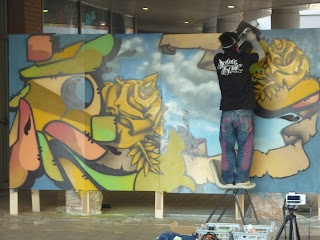For this final post, I would like to share my observations about the adopted customs and holidays in Japan. While living in Japan, I’ve had the opportunity to constantly compare my culture with the culture of Japan—although there are obvious differences there is one constant: cultural borrowing is a natural event and the adopted customs are taken and altered to fit the existing culture. In my first post I discussed the adoption of foreign words in to the Japanese language. The words taken from other languages are altered to fit the Japanese language, they are fully integrated and used as if they had originated from Japan; similarly, Japan has adopted Western holidays such as Halloween and Christmas in the same way.
The Halloween festivities at Kansai Gaidai was interesting to witness—seeing the exchange students and the Japanese students alike dressing up in costumes. In Japan, the main aspect of Halloween that is practiced is the costumes. This aspect is what the Japanese see as desirable and as such they use it to base their celebration of the adopted custom. In America as well, the celebration of Halloween has largely lost its original meaning and become a large advertising campaign; the festivities are largely meant for children to have fun by dressing up in costumes and getting sweets and candy. Culture takes the aspects of a tradition that most appeal to the populous and gives it its subsequent significance.
I was pleasantly surprised to see the great significance placed on the fall change of seasons here in Japan. The leaves changing colors is a natural worldwide event, but it seems to be given an added significance here than in America. It is Japanese culture that places added importance on the distinctions of each season (Koyo-changing of the leaves, yuki matsuri-snow festival, etc.). This is one aspect that as an American I would like to see this significance transferred to my own culture. This is not to say Americans do not appreciate the change in seasons, but as far as I know, there is not as much of a culturally festive atmosphere. In years previous, I have been in the midst of such natural beauty and been preoccupied with daily life that I missed one of natures greatest visual spectacles—the changing of the leaves in autumn.
 And finally, the last aspect of cultural borrowing I noticed is the Christmas festivities in Japan. Christmas is an obvious Western holiday, but Japan has taken the aspects that it likes best and added its own flair. For instance the Japanese traditional Christmas meal is the colonel’s KFC fried chicken and Christmas cake. It seems strange when one looks from the Western view of the holiday, but throughout this semester, I have learned to regard cultural borrowing as a separate entity—though the traditions and practices do not directly transfer, do they really have to? Christmas in Japan is its own unique practice and as such represents the aspects that its people find worthy of celebrating.
And finally, the last aspect of cultural borrowing I noticed is the Christmas festivities in Japan. Christmas is an obvious Western holiday, but Japan has taken the aspects that it likes best and added its own flair. For instance the Japanese traditional Christmas meal is the colonel’s KFC fried chicken and Christmas cake. It seems strange when one looks from the Western view of the holiday, but throughout this semester, I have learned to regard cultural borrowing as a separate entity—though the traditions and practices do not directly transfer, do they really have to? Christmas in Japan is its own unique practice and as such represents the aspects that its people find worthy of celebrating. This past weekend, I had the opportunity to go to Kobe to see the “light-up” event. I experienced my first ever pedestrian traffic jam—in order to see the illuminated sections, we had to walk with the masses of people through the closed off roads. The mood was very festive and for the first time this season, I was aware of the Christmas atmosphere. In America, I have gone to see Christmas lights before, but this experience is truly different from the Japanese “light-up”. My experience in Kobe also demonstrated to me that no matter where you are, your culture and the significance is what you the individual make of it. Japan’s affinity for Western traditions does not by any means, mean that they celebrate them in the same way. Instead, it is the taking of certain elements and the adaptation of those elements into the existing culture.













.jpg)
.jpg)






